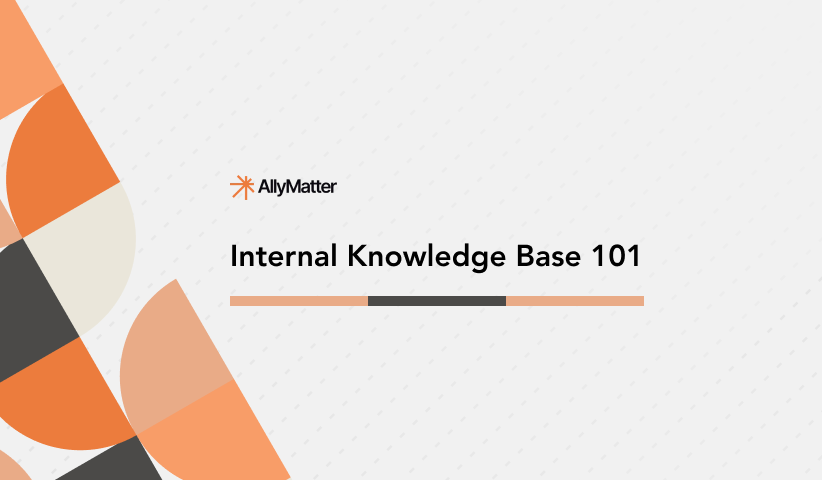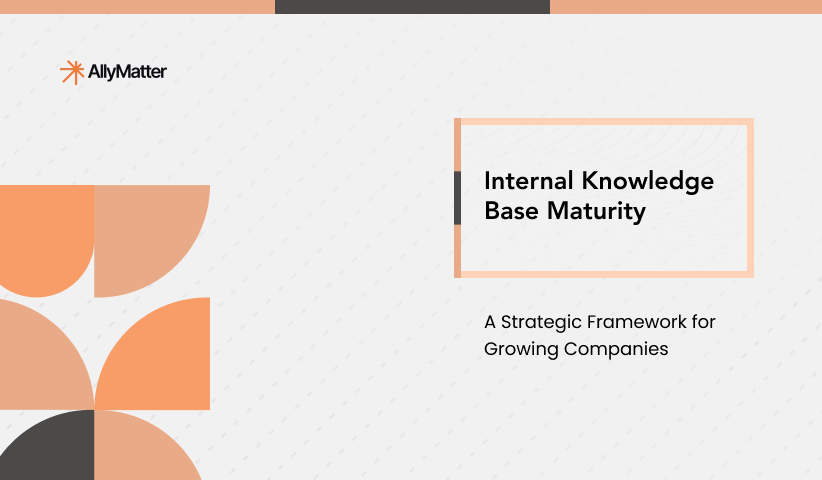In today’s rapidly evolving business landscape, the difference between companies that scale successfully and those that stumble often comes down to the effectiveness of their internal knowledge management. For growing organizations with 50 to 500 employees, an effective internal knowledge base isn’t just about documentation—it’s the foundation for sustainable growth.
Knowledge management challenges multiply as organizations grow. Teams spend significant portions of their workweek searching for information, repeatedly ask questions about standard processes, and struggle with knowledge gaps when key team members are unavailable. These are common symptoms of inadequate knowledge management that can impede growth and efficiency.
To overcome these challenges, a well-structured knowledge base is essential. Let’s explore the four essential pillars that support its success, along with practical insights for implementation and maintenance.
First Pillar: Accessibility & Organization
The most comprehensive knowledge base is worthless if your team can’t find what they need and when they need it. Accessibility begins with centralization—bringing scattered information into a single, organized system. This doesn’t mean dumping everything into one place; it means creating a structured environment where information is logically organized and easily discoverable.
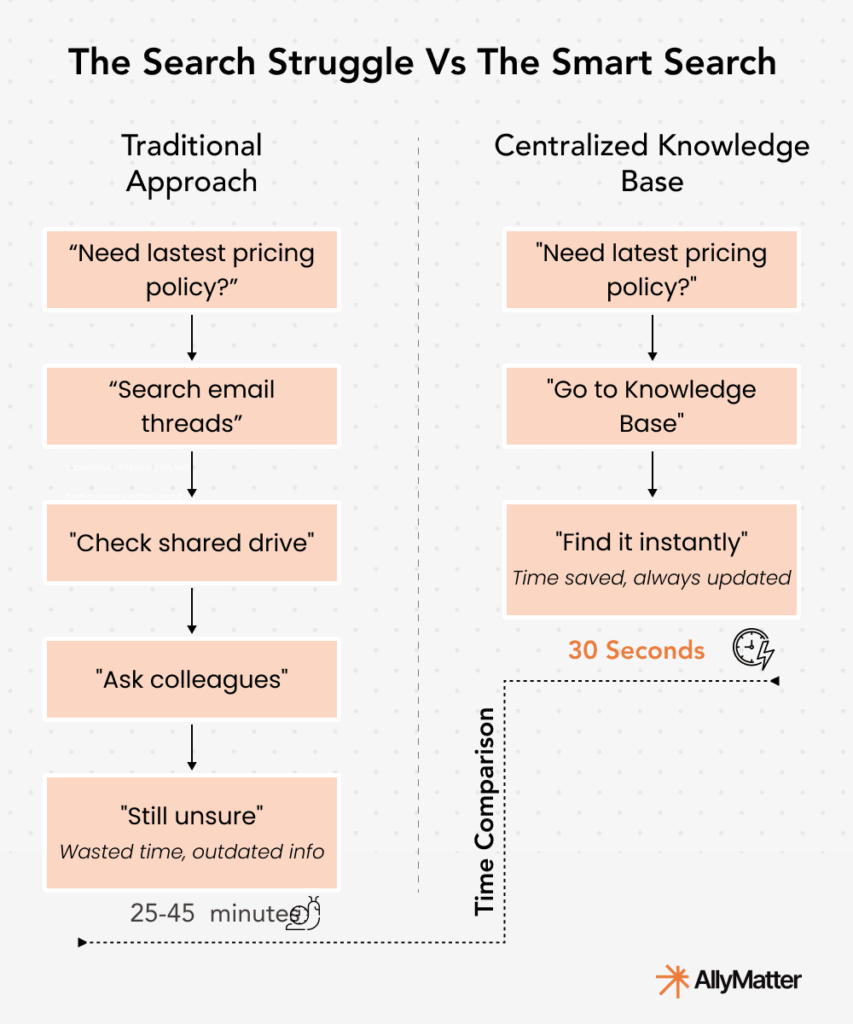
Practical example
Consider a common scenario in growing organizations: When promotional guidelines or pricing policies change, managers often spend hours searching through email threads and shared drives to find the most current version. A centralized knowledge base ensures that the latest information is immediately accessible to all authorized team members, eliminating the back-and-forth communication and reducing the risk of using outdated information.
Consider organizing your knowledge base by function rather than department. This approach reflects how people actually work and search for information. For instance, instead of having separate HR and Finance sections for expense policies, create a comprehensive “Expense Management” section that includes all relevant information, regardless of which department owns it.
Second Pillar: Content Quality & Standardization
Quality in a knowledge base isn’t about perfect prose—it’s about clarity, consistency, and reliability. Every document should follow standardized templates and guidelines, ensuring that readers know exactly where to find key information, no matter who created it.
Standardization should cover:
- Document structure and formatting
- Naming conventions
- Update frequency requirements
- Review and approval workflows
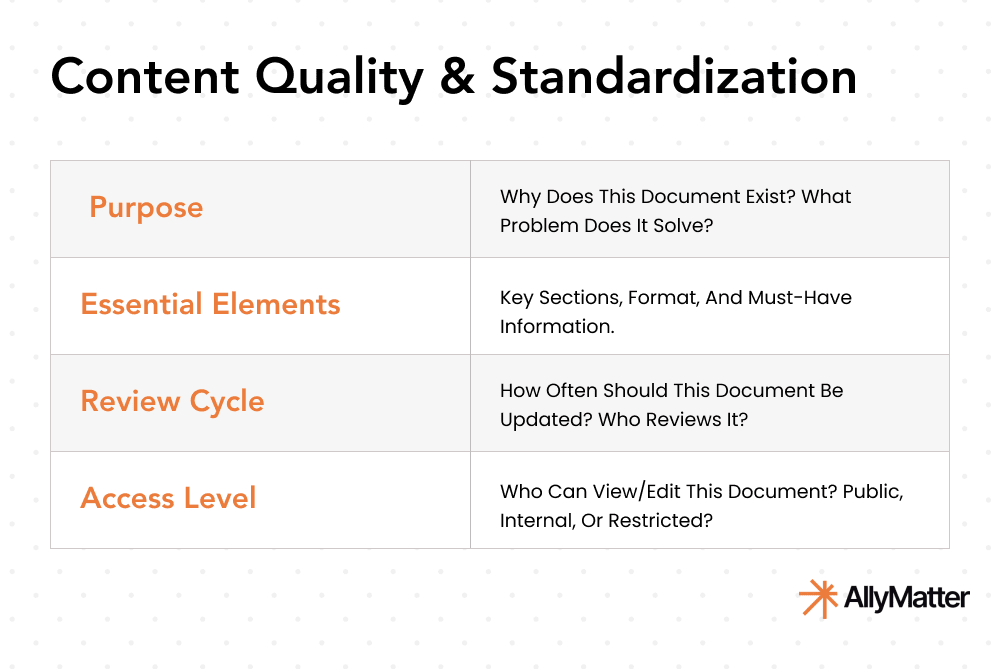
Practical tip
> Create a simple “Document DNA” for each type of content: Purpose, Essential Elements, Review Cycle, and Access Level. This helps maintain consistency while making it easier for contributors to create new content.
Third Pillar: Collaboration & Engagement
A knowledge base isn’t a static library—it’s a living system that evolves with your organization. Successful knowledge bases foster collaboration while maintaining control over content quality. The key is striking the right balance between encouraging contributions and ensuring accuracy.
Create clear ownership and accountability for different areas of your knowledge base. Assign subject matter experts as “knowledge champions” who are responsible for reviewing and maintaining specific sections. These champions should also actively seek input from users to ensure the content remains relevant and useful.
Business scenario
> When onboarding new team members, clear and up-to-date process documentation can significantly reduce training time and ensure consistency. Regular updates from experienced team members help keep the onboarding materials relevant and accurate.
Fourth Pillar: Maintenance & Governance
Without proper maintenance, even the best-designed knowledge base will become outdated and unreliable. Establish clear governance policies that outline:
- Regular Review Cycles: Set a defined review schedule for every document based on its importance and how frequently it changes.
- Archival Procedures: Not all content should live forever. Define clear criteria for archiving outdated information while maintaining access to historical records when needed.
- Compliance Requirements: Ensure your governance model includes necessary compliance elements, particularly for regulated industries or sensitive information.
Practical example
> Regular knowledge base audits ensure content stays current. For instance, having quarterly reviews where team leaders verify their section’s accuracy helps prevent the accumulation of outdated information while maintaining compliance standards.
Implementation Strategy
Successfully implementing these four pillars requires a thoughtful approach to change management. Start small with a pilot program in one department or function. Use the lessons learned to refine your approach before rolling out to the broader organization.
Focus on measuring both efficiency improvements and user adoption. Track metrics that matter to your organization, such as time saved in information retrieval and consistency in process execution. Regular feedback from users can help identify areas for improvement and guide the evolution of your knowledge base.
Why AllyMatter for Knowledge Base Excellence
While the principles outlined above can be implemented with various tools, purpose-built platforms can significantly streamline the process. AllyMatter addresses each of the four pillars through features designed specifically for growing organizations.
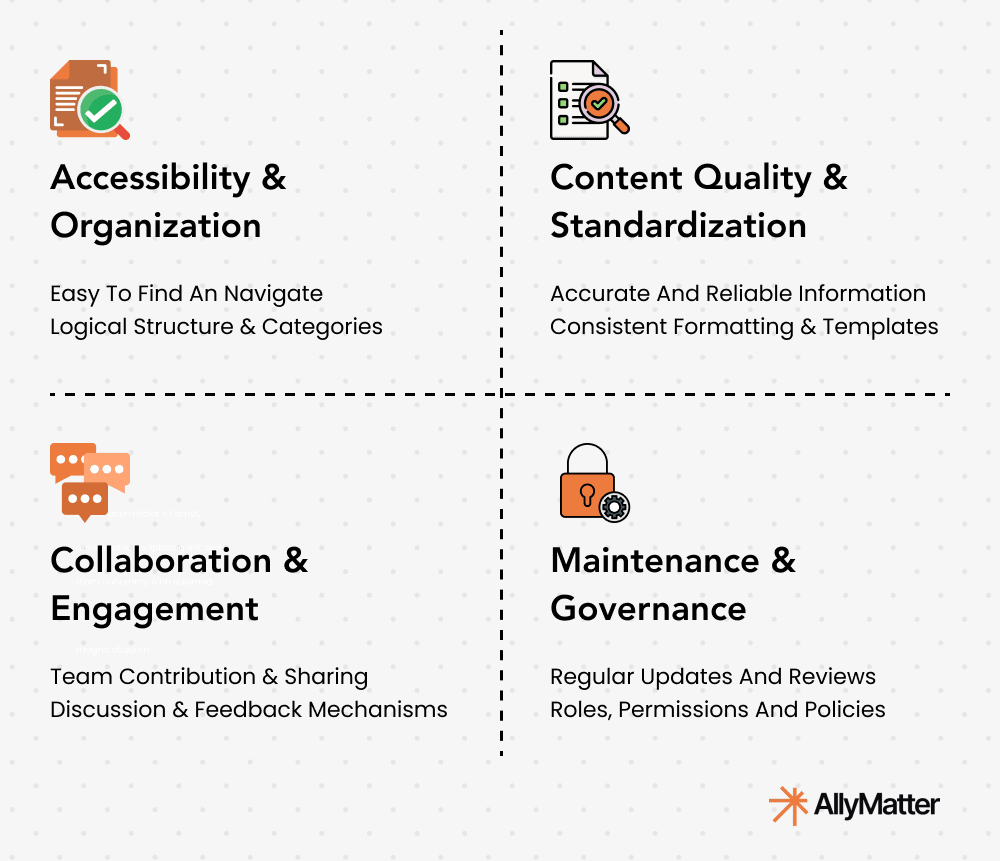
Supporting accessibility and organization AllyMatter provides a central location for all internal documentation, eliminating scattered information across multiple drives and email threads. The platform offers intelligent organization with smart tags, custom categories, and powerful metadata search, making it easy to find any document quickly.
Enhancing content quality and standardization Built-in approval workflows ensure proper review and approval before publication, while version control automatically maintains a clear history of changes. This is particularly valuable for compliance documentation and standard operating procedures that need regular updates as organizations grow.
Fostering collaboration and engagement The platform enables secure collaboration with commentary features and controlled editing permissions. Teams can work together effectively while maintaining proper oversight of who can make changes to critical documents.
Streamlining maintenance and governance Comprehensive audit trails track every change for full accountability and effortless compliance. The system maintains detailed records of document approvals and acknowledgments, supporting regulatory requirements while simplifying governance processes.
Building Your Knowledge Foundation for Sustainable Growth
Building an effective internal knowledge base is a journey, not a destination. By focusing on these four pillars—accessibility, quality, collaboration, and maintenance—organizations can create a strong foundation for managing their collective knowledge. The key is to start with clear principles and gradually build a system that grows with your organization.
Remember that the goal isn’t perfection from day one, but rather continuous improvement guided by user needs and organizational objectives. Begin with the basics, measure what matters, and evolve your knowledge base as your team grows and changes.
For organizations serious about scaling efficiently, an effective knowledge base isn’t optional—it’s a fundamental building block of sustainable growth. The time and effort invested in getting it right will pay dividends in improved productivity, faster onboarding, and more consistent operations across your organization.
Ready to transform your organization’s knowledge management? Join our waitlist to be among the first to experience how AllyMatter can help you implement these four pillars effectively.
Frequently Asked Questions (FAQs)
What’s the difference between a knowledge base and a document management system?
A knowledge base goes beyond simple document storage by creating structured, searchable content designed for specific workflows. While document management systems organize files, knowledge bases include approval workflows, version control, and role-based access controls that enable better governance and compliance.
How long does it take to see results from implementing these four pillars?
Organizations typically see initial improvements in information retrieval within 4-6 weeks of implementing proper accessibility and organization. However, full benefits become apparent after 3-6 months, once content quality standards are established and maintenance routines are in place.
Which pillar should growing companies prioritize first?
Start with accessibility and organization. Without proper structure and centralization, even high-quality content becomes difficult to find and use. Once your information is properly organized and accessible, focus on content quality and standardization.
How do we encourage team members to contribute without compromising quality?
Establish clear content ownership with designated subject matter experts for each area. Create simple templates and guidelines for contributors, and implement approval workflows to maintain quality while encouraging participation from across the organization.
What metrics should we track to measure knowledge base success?
Focus on time saved in information retrieval, reduction in repeated questions, user adoption rates, and content utilization patterns. Track both efficiency improvements and user satisfaction through regular feedback collection.
